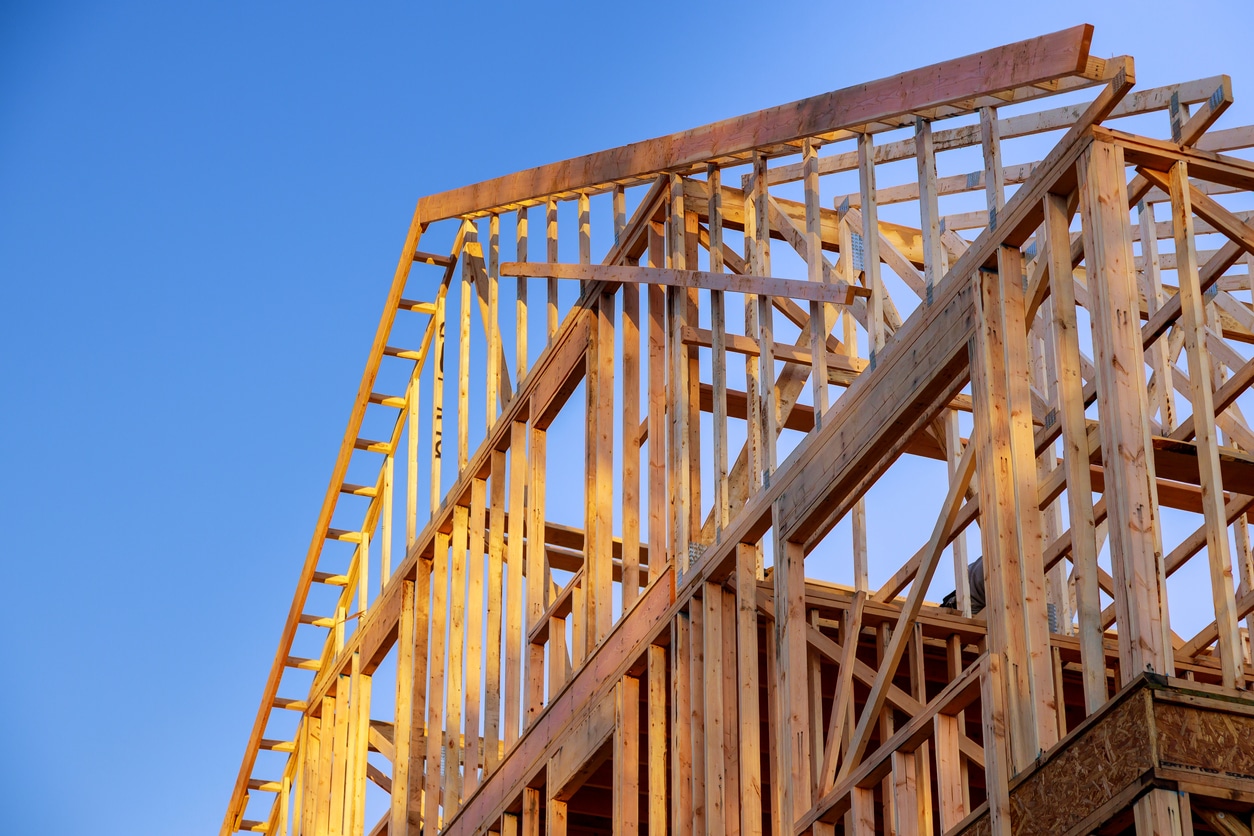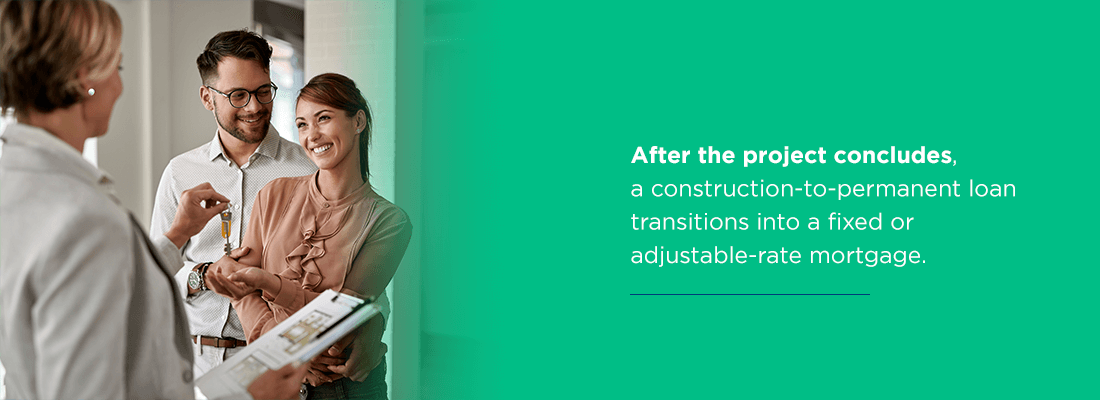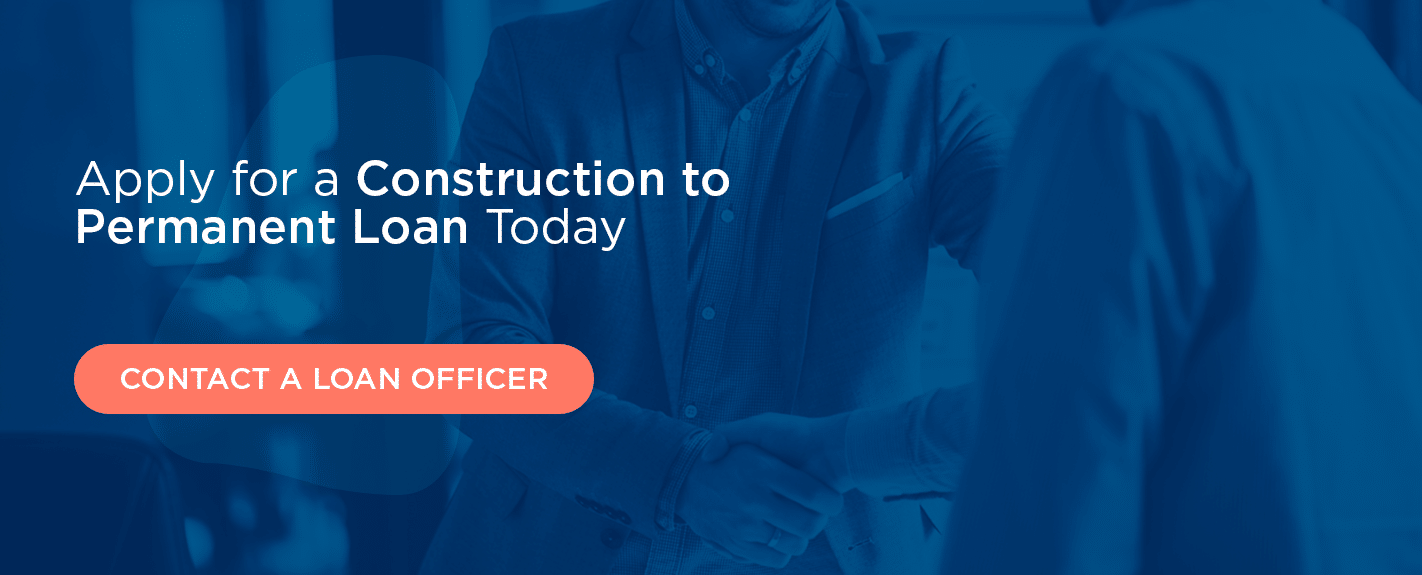-
- A construction-to-permanent loan brings you through the entire process of buying and completing construction with a single loan.
This loan helps you avoid obtaining separate lots and construction financing, meaning there are fewer moving pieces. Toward the end of the construction period, you can work with your lender to change the construction loan into a permanent loan. This type of loan can cut down on the confusion, paperwork and headaches associated with getting several different loans and financing options. It makes sure everything is in one place. However, you must still apply for it, and just like any other loan, this one depends on whether you own the land.
If you do not own the land you’re building on, a construction loan streamlines the borrowing process to one closing transaction.
If you own the land on which you’re building, remodeling or renovating, a construction loan is still advantageous. It will ensure you have the funds you need to do new construction or a rebuild on the property you currently own, helping you transition into a permanent loan.
Topics covered:
- What is a construction-to-permanent loan?
- Uses for construction loans
- The construction phase and how it works
- The process of moving a construction loan to a permanent loan
- Benefits of construction-to-permanent loans
- Disadvantages of construction-to-permanent loans
- What are the requirements for a construction loan?
- Construction-to-permanent loan rates
What Is a Construction-to-Permanent Loan?
Construction-to-permanent financing is a type of loan which allows you to build or renovate your home. When the construction process concludes, this loan rolls over into a traditional mortgage without you having to go through another closing. You’ll only have to pay for one set of closing costs.
A construction-to-permanent financing loan may suit you for several reasons. This financing allows you to borrow up to $2 million. You lock in construction-to-permanent mortgage rates when you apply, so you may not have to worry about increasing interest rates as you build.
You can use this type of loan for a lot, a build on your lot or renovations. It can cover labor and material costs for your primary or vacation residence. Your property must also be a one-unit, single-family home to qualify for a construction-to-permanent loan.
During the construction phase, you’ll make interest-only payments, and your lender will schedule home inspections to check in on how the home construction is progressing. After closing, you use the remaining savings from your down payment to pay your builder so they can begin construction. When your remaining down payment savings are gone, you can then draw from your construction-to-permanent loan to fund construction costs.
After the construction concludes, the loan will then become a permanent loan, such as a conventional loan with a 30-year term.
About Construction Loans and Uses for Construction Loans
No matter how excited you are to begin the construction process on your dream home, you may still be feeling a bit overwhelmed about all the unknowns of construction loans. That’s why we want to help you understand the basics — so you can feel comfortable moving forward with the construction process.
1. Types of Construction Loans
You can obtain one of two main types of construction loans.
- Stand-alone construction loan: In this situation, you’ll acquire two separate loans. The first is solely for the construction of your home — the stand-alone construction loan. This loan covers your construction costs. After construction concludes, you’ll secure a separate traditional loan.
- Construction–to–permanent loan: In this situation, you’ll obtain only one loan. At first, the loan pays for the home’s construction costs. Then, after you move in, the loan converts into a permanent loan. Essentially, you get two loans in one rather than dealing with two separate loans.
2. Drawing From Your Loan to Pay for Construction
Unlike conventional loans, lenders don’t provide construction loans in a single lump sum. Instead, they pay out in smaller installments, known as draws, throughout the construction process. When the construction wraps up, the lender transfers the total cost amount to you, the borrower.
A draw goes to the builder for reimbursement of the construction costs. Because a draw is a reimbursement, you or the builder must pay for construction costs upfront. Before making these draws, the lender will perform an inspection to estimate the cost and assess project progress.
3. Construction Loan vs. Home Equity Line of Credit
When making home improvements, you may want to select between a construction loan and a home equity line of credit. A HELOC is a line of credit a lender gives to the borrower against the equity in their home.
- A HELOC has a fixed interest rate repaid over the home loan term, which is typically 15 to 30 years.
- A construction loan will have higher monthly payments because of its limited term, usually three to five years.
- You’ll typically pay less interest for a construction loan than for a HELOC because construction loans have a fixed interest rate over a short duration, while you’ll generally repay a HELOC over many years.
- Borrowers typically repay a HELOC in interest-only payments for the initial five to 10 years. The interest rate will increase when you begin making principal payments.
Construction loans aren’t only for building a new home — they can also be an excellent loan option for home improvements.
[download_section]
The Construction Phase and How It Works
During the construction phase, you’ll navigate disbursements, inspections, draws and statements.
- Disbursements: Before you receive each of your loan fund disbursements, your lender schedules an inspection to check in on the initial work. You use your money first and then receive loan disbursements. The amount you receive in a disbursement corresponds to the construction progress. Your lender disburses funds to reimburse for materials installed or labor completed.
- Inspections: You can contact your lender so they can schedule an inspection to determine the percentage of work the builder has completed according to your draw schedule. You also may want to schedule an inspection if you’re concerned about the quality of the workmanship on your home.
- Draws: Once you place a draw request, your lender will generally release those funds within two to three business days.
- Statements: In the month after your initial disbursement, you’ll receive monthly statements. Each statement will list the interest that has accrued on the disbursed loan funds.
The Process of Moving a Construction Loan to a Permanent Loan
There are several steps to move a construction loan to a permanent loan.
- Finish construction: A construction loan typically has a loan term of six months to two years. The homebuilding process ends when the loan disbursements and draw periods conclude, and every party has received payment for labor and materials.
- Schedule a final inspection: After construction wraps up, you need to schedule a final inspection. The building inspector will ensure your property complies with your area’s building codes. After a successful inspection, you’ll receive a certificate of occupancy.
- Shop for a permanent loan: After you have your home built, inspected and certified, you can start browsing your options for a permanent loan. A loan conversion will already be in place for a construction-to-permanent loan, but if you have a construction-only loan, this is the point in the process when you’ll begin searching for the right mortgage for you.
- Schedule an appraisal: During the appraisal, a professional will assess the property to determine its value compared to other property sales that have recently occurred in your area. This task can be tricky if there aren’t many comparable sales. If your home is more upscale or unique than other houses in your neighborhood, it may be challenging for your appraiser to find comparable properties, which can significantly impact your home’s value. The appraisal is pivotal for securing a conventional, permanent mortgage so the lender can assign a value to the collateral.
- Apply for a permanent mortgage: Now you’re ready to apply for a permanent mortgage. Remember the requirements for the types of mortgages you’re interested in, such as your credit score, your cash reserves and your debt-to-income ratio. These factors will determine whether you qualify for specific mortgage options. For an idea of what you can afford to spend, you can use our home mortgage calculator.
- Finish the conversion: After the loan has closed, you’ll begin making your mortgage payments.
The Benefits of Construction-to-Permanent Loans
Let’s go over the basics — a construction-to-permanent loan will let you borrow upward of $2 million, locking in interest rates when you apply and enabling you to finance a lot or build on a lot for your primary residence or vacation home. Now, let’s cover the specific benefits of a construction-to-permanent loan for your home construction.
1. Save Money and Time
The primary advantage of construction-to-permanent loans is that you do not have to choose a construction loan and then close on a second, permanent loan when your construction completes. This solution will save you the hassle of finding an additional loan and save you money on closing since you’ll only have fees associated with closing on one loan.
At the end of the construction period, your home construction financing will convert into a permanent loan without additional closing costs. Then, you will begin paying interest and principal each month. By securing a construction loan and permanent mortgage at once, you’re also avoiding any changes in the market during or after construction. You can avoid potentially higher interest rates, saving you money in the long term.
2. Easier to Qualify
Construction-to-permanent loans are also easier to qualify for than stand-alone construction loans. A construction loan is riskier for a lender because they can’t use an existing home as collateral if you can’t pay back the loan, so the borrower has to meet many eligibility requirements. You’ll need to supply your lender with details about the contractors and subcontractors, the materials they will use and the home’s size. The lender also needs to believe that you can pay your monthly payments for you to qualify. They may require you to have an excellent credit score, cash reserves, a significant down payment and a low debt-to-income ratio.
For borrowers who don’t have these qualifications, a construction-to-permanent loan is generally a better option than a stand-alone construction loan. In some cases, you may not qualify for a construction-only loan, so a construction-to-permanent loan may be your only option.
3. Interest-Only Payments During Construction
With a construction-to-permanent loan, you get a 12-month period where you make interest-only payments on already distributed funds. As you transition into a permanent loan, you can decide if you want a fixed or adjustable-rate loan for financing.
By not having to pay down the principal during the construction phase, your payments will be lower, and you’ll have more time to save or spend that extra money on unexpected construction costs.
4. Flexible Terms
Even though you’ll provide your lender with plans for the property’s construction, a construction loan tends to be more flexible than a traditional loan in its guidelines and loan terms. You can probably adjust your loan terms to work with your needs as progress continues on your new property.
If you want to build on a lot you own or extensively renovate your property to make it your dream house, a construction-to-permanent loan may be the right financing for you.
Disadvantages of Construction-to-Permanent Loans
Though a construction-to-permanent loan is an excellent option for many borrowers looking to build a new home, there are a few disadvantages to this type of loan or instances in which you may want to opt for a different loan.
- Potentially higher interest rates: Interest rates on construction-to-permanent loans tend to be higher than conventional loans because of their increased risk. A lender needs to be sure that they are making a smart investment by allowing you to borrow money, and they will protect themselves by charging a higher interest rate than you may be able to find for other mortgage types.
- Larger down payments: For a construction-to-permanent loan or a construction-only loan, lenders typically want a substantial down payment. Depending on your home’s anticipated cost, you may have some difficulty saving up a down payment of 20% or more.
If the construction loan is for a second home, you may want to take out a stand-alone construction loan if you can pay a smaller down payment, and you’ll sell your first home to move into the new construction. Ideally, you’ll have a lot more cash after you sell your current home, and you can continue living in your home while the second property is under construction.
Frequently Asked Questions About Construction-to-Permanent Loans
Now, you probably have a reasonable idea about whether a construction-to-permanent loan is an option for you and your homebuilding project. With such a significant undertaking, you want to be confident that you have as much information as possible about the process of constructing and taking out a loan. We’ve gathered answers to some of the most frequently asked questions about construction-to-permanent loans.
1. What Are the Requirements for a Construction Loan?
Construction-to-permanent loan lenders may be taking a more significant risk with a construction loan than with a traditional mortgage. After all, many construction processes face unpredictable hurdles. Renovations and builds can experience delays or go over budget, and the result may not be worth as much as projected.
To protect against these issues, construction-to-permanent loan requirements require you to have the following.
- A good builder: You will need to speak to an experienced, licensed and insured builder who has worked on similar projects. Check recommendations and backgrounds carefully to find a licensed general contractor who can do the work.
- Details of the build: Once you have a builder, make sure you have what is known as a “blue book” of the construction project, which will list everything from floor plans to the materials you will use in your new home or renovation.
- Good credit: You may need a credit score of at least 680 and ideally of 700 to 720 or higher to qualify for this type of financing.
- An estimate: You may need to work with an appraiser to determine the expected home value. Whether you need this step will depend on your circumstances and your lender.
- A down payment: You may need a down payment of 20%, but this number may vary widely, depending on your assets, circumstances, proposed project and more. If you are not sure how much you need, you can speak to a loan officer at Assurance Financial to get details about how to qualify for a loan.
- Cash reserves: A construction loan reimburses the builder, which means the builder or borrower needs to have the cash reserves to cover the costs of construction upfront. As a result, you might need to save up a lot of money beforehand.
You’ll also want to understand your home’s equity to help you decide whether to get a construction loan or a home equity line of credit. You’ll need equity in your home to take out a HELOC. Your line of credit will depend on the equity you have in your home — not your home’s total value.
Understanding the requirements for obtaining a construction-to-permanent loan is critical to ensuring you will qualify for a loan when you’re ready to build your dream home.
2. What Percent Do You Put Down for a Construction-to-Permanent Loan?
Because construction-to-permanent loans cover more than the cost of purchasing a finished home, down payment requirements are usually higher than regular construction loans. Most lenders ask that you make a down payment of about 20% of the property’s projected value, at minimum, while others may require up to 25 or 30%. If you put less than 20% down, the lender will probably require you to have private mortgage insurance to protect their lending investment.
While you can have a general expectation about the down payment needed for a construction-to-permanent loan, all lenders have different requirements. For example, FHA loans typically require a low down payment because they are for lower-income homeowners, and USDA loans require no down payment at all. Your lender can assess your situation and give you an accurate estimate.
3. Is It Cheaper to Buy or Build a House?
The answer to this question depends on several factors unique to each potential homeowner. Variables that influence price include the property’s location and the home’s style and size. With construction projects, delays may emerge due to weather, shipping setbacks or other unexpected holdups, which can set you behind schedule. There are no setbacks like this when buying a finished home if an inspector doesn’t detect any issues.
New construction can also provide you with several areas for saving. You have the flexibility to choose a less expensive property, like one further from a city center. Buying off-plan property or a vacant lot can lower stamp duty, the property tax based on the land’s value at the time of sale. Some states also offer grants specifically for first-time homeowners. When exploring this option, carefully consider long-term payment requirements.
4. How Many Years Is a Construction Loan?
Construction loans of all kinds are short-term, lasting only about six months to two years. This term gives enough time for the contractor to build the property and for you to move in. Because of this shortened timeframe, the lender must receive a detailed and realistic budget with a construction timeline. During the construction period, or each time you want to draw more loan funds, the lender will make inspections to see how the project is progressing.
After the project concludes, a construction-to-permanent loan transitions into a fixed or adjustable-rate mortgage. Terms for these kinds of mortgages are usually 15 to 30 years. All told, you may be paying on a construction-to-permanent loan for anywhere from 16 to 32 years.
Construction-to-Permanent Loan Rates
Because you will lock in a construction-to-permanent loan for a long-term basis, you may get a higher interest rate. The longer the loan term is, the higher the interest rate tends to be. Your rate may also be higher if the property owner is also the builder, as the construction may not be of the same quality and meet the standards as the work of a licensed contractor. Fortunately, as your home gets closer to completion, you may get a lower rate.
With a construction-only loan, you might qualify for a lower rate since the loan will be for a shorter duration. However, with a construction-only loan, you also risk getting a higher interest rate for your permanent loan if the market changes or if your financial situation worsens.
Construction-to-Permanent Options and Loan Lenders
Not every lender offers construction loans, and some will only provide construction loans if borrowers can meet rigorous requirements. That’s why comparing lenders is so critical for finding an ideal option for your home construction.
Assurance Financial has several options for your construction-to-permanent loan needs. We have these single-closing loans and two-closing loans if you prefer the added flexibility. Our team provides loans for homebuyers and builders. If you meet the requirements for a USDA loan and your project meets specific thermal standards, you may even qualify for USDA construction-to-permanent loans, which may come with competitive rates.
Assurance Financial understands it can be challenging to find the right financing product for you. If you have a vision for your home, come to us, and we may be able to help make that dream a reality with practical suggestions and loan products. Since we underwrite in-house and don’t shop your mortgage around, we may be able to offer flexibility to help meet your needs.
Apply for a Construction-to-Permanent Loan Today
You don’t want a loan — you want a home. Assurance Financial understands that. It’s why we pride ourselves on being The People People with technology. We treat you like a person, not a number, and we explain your options in plain English. We are not just about numbers, but rather about your homeownership goals.
Our goal is to help more Americans reach the dream of homeownership. It’s why we focus on mortgages and offer a range of loan products to help you accomplish your goals. Whether you’re building new construction, renovating or buying an existing home, Assurance Financial has loans for you.
Ready to apply? You can speak to a person, as we have mortgage experts licensed in 28 states. Our friendly and experienced professionals can listen to your goals and concerns and address them with customized advice.
Our process is simple. We pre-qualify you in 15 minutes by pulling your credit score and offering you a free, no-obligation quote on a rate. Once you have found your home, builder or are ready to refinance your property, fill out the full application. We take care of processing, including in-house underwriting, and let you know if you have approval. Once you sign with a notary to close your loan, you can start breaking ground on your new home or moving. Since we handle end-to-end processing without outsourcing, we can take care of your application quickly and answer your questions.
To begin building your dream home, you first need to ensure you have all the funds required. We take the stress out of the entire process with our construction-to-permanent loans, making everything easier, faster and all in one place.
If you need help converting your construction loan into a permanent one or are interested in financing a new build, contact our loan officers and let us help you find the perfect option for you!
Linked Sources:
https://assurancemortgage.com/remodeling-construction/
https://assurancemortgage.com/construction-loans/
https://assurancemortgage.com/vacation-home/
https://assurancemortgage.com/down-payment-home-loan/
https://www.hud.gov/topics/common_questions
https://crsreports.congress.gov/product/pdf/RS/RS20530#page=6
https://www.investopedia.com/mortgage/heloc/
https://assurancemortgage.com/usda-loans/
https://assurancemortgage.com/fha-loans/
https://assurancemortgage.com/find-a-loan-officer/
Unlinked Sources:
https://www.forbes.com/advisor/mortgages/construction-loans/
https://www.bankrate.com/mortgages/construction-loans-explained/
https://time.com/nextadvisor/mortgages/what-are-construction-to-permanent-loans/
https://www.mebank.com.au/the-feed/build-or-buy-your-first-home/






